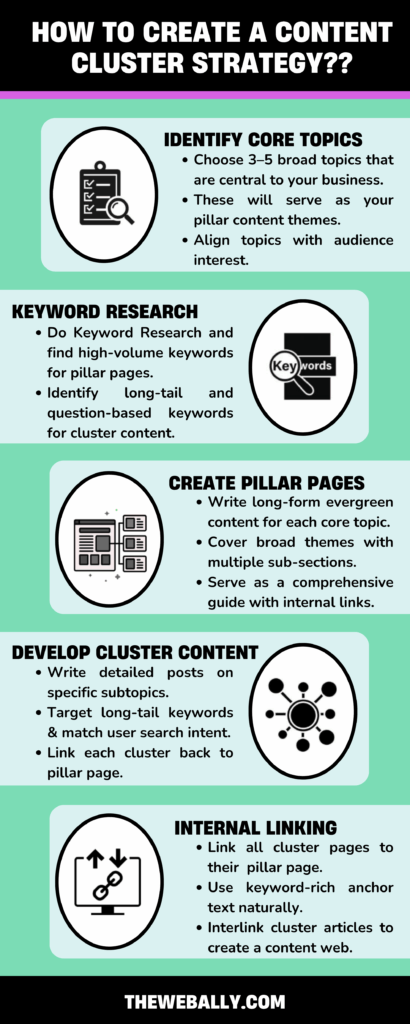In today’s SEO landscape, it’s no longer enough to target individual keywords with isolated blog posts. Search engines, especially Google, now reward content that demonstrates topical authority, relevance, and comprehensive coverage of a subject. That’s where content clusters come into play.
In this article, we’ll break down what content clusters are, why they matter for SEO, and how your business can implement them to boost search visibility and organic traffic.
A content cluster (also known as a topic cluster) is a strategic SEO framework where multiple related pieces of content are linked together around a central theme. The structure includes:
This approach helps search engines understand the relationship between different pieces of content, boosts topical authority, and improves site architecture for both users and crawlers.

Search engines prioritize websites that are perceived as experts on a subject. Clusters allow you to cover every angle of a topic, signaling to Google that your site offers depth and breadth.
While traditional SEO focused on one keyword per post, content clusters help you target a wider variety of long-tail and semantic keywords, capturing more search intent.
Clusters naturally guide users through related content, keeping them on your site longer. This increases dwell time and decreases bounce rate—both positive behavioral signals for SEO.
Internal links distribute link equity across your cluster, helping lesser-known or newer pages gain visibility. They also assist search engines in crawling and indexing your site efficiently.
Choose 3–5 broad topics that are central to your business or niche. These will serve as your pillar content themes. For example, a digital marketing agency might choose:
These topics should align with what your audience is searching for and where you want to build authority.
Use tools like SEMrush, Ahrefs, or Google Keyword Planner to identify keywords and subtopics around each core theme. Prioritize:
Develop long-form, evergreen content (typically 2,000+ words) that broadly covers the core topic. Pillar pages should serve as a comprehensive overview, touching on subtopics without diving too deep.
For example, a pillar page titled “The Complete Guide to Content Marketing” might include sections on:
Each section then becomes a potential cluster topic.
Create individual blog posts or resources that cover specific aspects of the core topic in detail. Each post should:
Example cluster articles for content marketing:
Ensure every cluster page links to the pillar page with appropriate anchor text. Also, interlink related cluster articles to create a web of relevance. This reinforces topic relationships for search engines.
Track performance using Google Search Console and analytics tools. Monitor:
Update your content regularly to stay relevant and to reflect algorithm updates or changes in user behavior.
Real-World Example: Content Cluster in Action
Let’s say you run a digital marketing agency and want to rank for “Email Marketing.”
With each cluster post internally linked to the pillar and optimized for related keywords, you build a strong network of authority around “email marketing.” Google sees this as a comprehensive topical resource, increasing your chances of ranking for both short- and long-tail terms.
Content clusters aren’t just an SEO tactic—they’re a content strategy framework that aligns with how search engines and users consume information today. By creating structured, interconnected content around core topics, you build trust, visibility, and authority over time.
For digital marketing agencies and businesses alike, embracing this approach means:
If your current blog strategy is still focused on isolated posts, it’s time to pivot.
As a full-service digital marketing agency, The Web Ally specialize in SEO content architecture, pillar page development, and long-form content creation. Let’s build a strategy that actually ranks.
Self-service covers every aspect of life these days, but we still believe in the power of having someone to talk to. Maybe it's to bounce off ideas and explore new opportunities. Maybe it's just to say hello.
In any case, we will only use your contact details to get in touch with you regarding your enquiry - and nothing else!